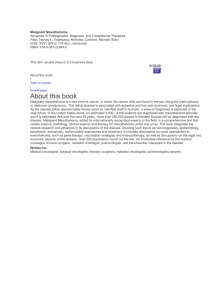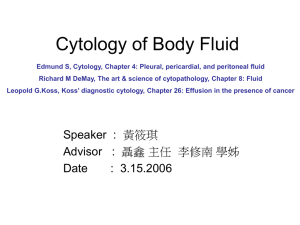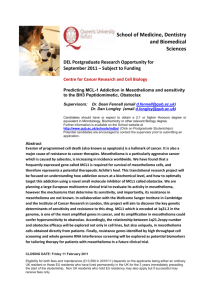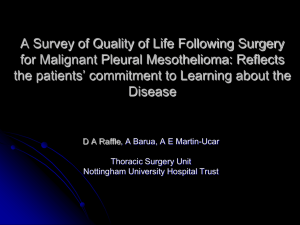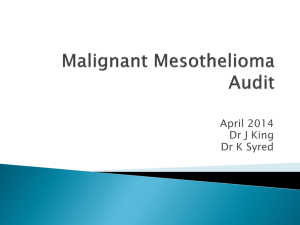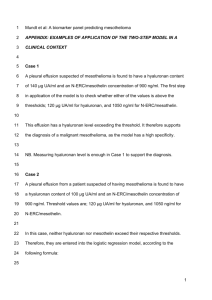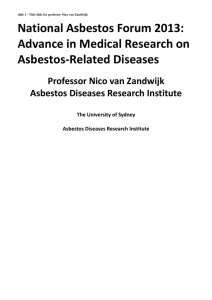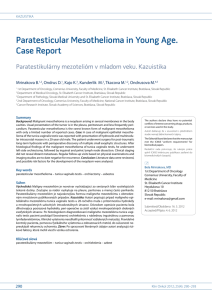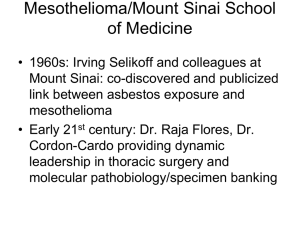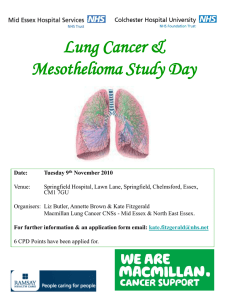Body cavity effusions are among the most commonly received
advertisement
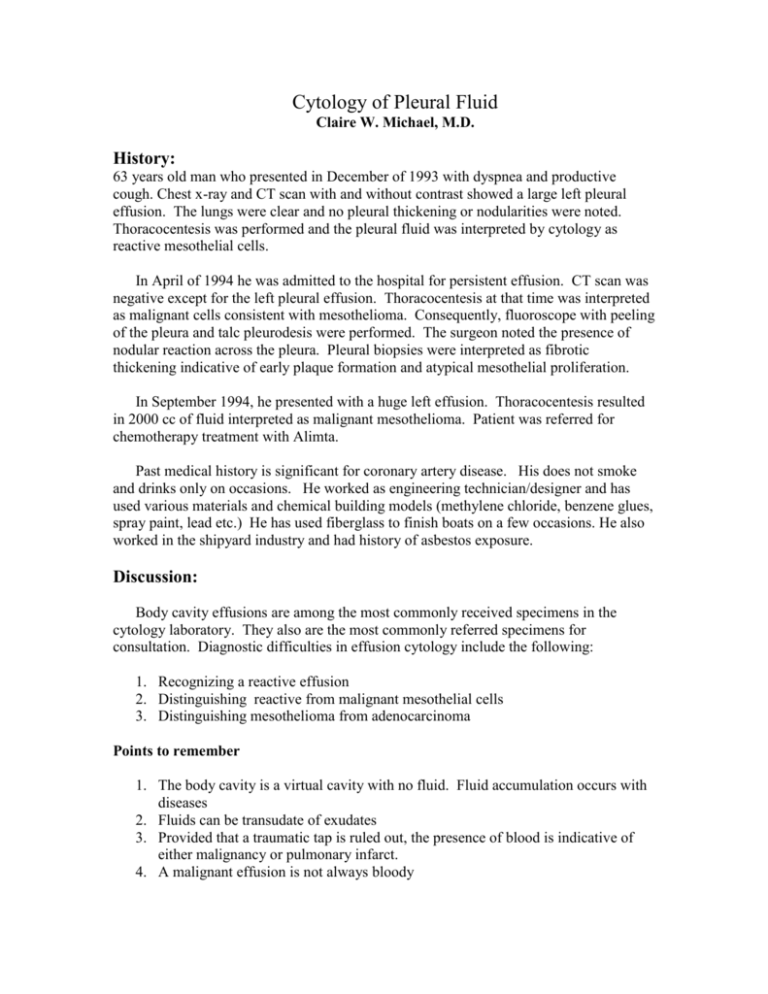
Cytology of Pleural Fluid Claire W. Michael, M.D. History: 63 years old man who presented in December of 1993 with dyspnea and productive cough. Chest x-ray and CT scan with and without contrast showed a large left pleural effusion. The lungs were clear and no pleural thickening or nodularities were noted. Thoracocentesis was performed and the pleural fluid was interpreted by cytology as reactive mesothelial cells. In April of 1994 he was admitted to the hospital for persistent effusion. CT scan was negative except for the left pleural effusion. Thoracocentesis at that time was interpreted as malignant cells consistent with mesothelioma. Consequently, fluoroscope with peeling of the pleura and talc pleurodesis were performed. The surgeon noted the presence of nodular reaction across the pleura. Pleural biopsies were interpreted as fibrotic thickening indicative of early plaque formation and atypical mesothelial proliferation. In September 1994, he presented with a huge left effusion. Thoracocentesis resulted in 2000 cc of fluid interpreted as malignant mesothelioma. Patient was referred for chemotherapy treatment with Alimta. Past medical history is significant for coronary artery disease. His does not smoke and drinks only on occasions. He worked as engineering technician/designer and has used various materials and chemical building models (methylene chloride, benzene glues, spray paint, lead etc.) He has used fiberglass to finish boats on a few occasions. He also worked in the shipyard industry and had history of asbestos exposure. Discussion: Body cavity effusions are among the most commonly received specimens in the cytology laboratory. They also are the most commonly referred specimens for consultation. Diagnostic difficulties in effusion cytology include the following: 1. Recognizing a reactive effusion 2. Distinguishing reactive from malignant mesothelial cells 3. Distinguishing mesothelioma from adenocarcinoma Points to remember 1. The body cavity is a virtual cavity with no fluid. Fluid accumulation occurs with diseases 2. Fluids can be transudate of exudates 3. Provided that a traumatic tap is ruled out, the presence of blood is indicative of either malignancy or pulmonary infarct. 4. A malignant effusion is not always bloody 5. The presence of hemosiderin laden macrophages is indicative of chronic RBCs leak Benign mesothelium Quiescent mesothelium: 1. A monolayer of flattened sheets with epithelial features (classic example are sheets seen in pelvic washes) 2. Cells break off as single cells or in few small groups 3. Round to oval cells, 15-20 µm in diameter 4. Cytoplasm is moderate in amount, translucent, and contain peripheral vacuoles containing glycogen 5. Long slender microvilli under light microscopy appear as a pale zone at the periphery causing a fuzzy or a brush like appearance. 6. The central portion of the cytoplasm is denser and darker due to the perinuclear intermediate filaments resulting in a two- tone or endo-ectoplasmic demarcation. 7. Cells may be single or binucleated 8. Nuclei are monotonous, centrally located, and oval to round, with evenly distributed chromatin. 9. Nucleoli are indistinct 10. Occasional cells exhibit the characteristic “window” and “cellular clasping” appearance Reactive/hyperplastic/hypertrophic mesothelium 1. 2. 3. 4. 5. Shed as doublets or triplets with windows between them. Few papillary groups may be formed Connections by clasp-like articulations are more obvious Cells are round to oval, 20-40µm in diameter Abundant cytoplasm with endo-ectoplasmic demarcation and peripheral submembranous vacuoles 6. Cytoplasmic protrusions distal to cellular connection 7. Nuclei are round to oval with some variation in size and chromatin distribution. The cell size may vary slightly, however, within a small range and only few cells will appear out of proportion. 8. Nucleoli may become prominent 9. Multinucleated cells increase 10. Occasionally intranuclear inclusions are noted Causes of mesothelial hyperplasia 1. Heart failure 2. Infection (pneumonia, lung abscess) 3. Infarction (may shed in sheets) 4. Liver disease such as hepatitis or cirrhosis (may cause pronounced hyperplasia) 5. Collagen disease 6. Renal disease such as uremia or peritoneal dialysis 7. Pancreatic disease 8. Radiation (split field, tandom ovoids) 9. Chemotherapy (bleomycin, cytoxan) 10. Traumatic irritation (hemodialysis, surgery) 11. Chronic inflammation (PID, pleuritis) 12. Underlying neoplasm causing irritation of the mesothelium (fibroid) 13. Foreign substance (talc, asbestos) Note: Hyperplasia and hypertrophy with papillary formation may be so pronounced and may mimic malignancy (mesothelioma or adenocarcinoma). Malignant mesothelioma Malignant mesothelioma is a rare disease with an average incidence of 2 cases per 1 million people per year in the United States. However it is extremely important to recognize it since mesothelioma has different therapeutic implications from other tumors. In addition, its recognition will spare the patients repeated procedures such as core biopsies that frequently carries the risk of seeding along the needle tract. Malignant mesothelioma may result into a very cellular fluid; however it is not unusual to obtain a fluid with low or scant cellularity. The increase in cell size is one of the most prominent features in mesothelioma (attain a gigantic size). Gross appearance: Early stage: appears as hundreds of tiny nodules on the serous membrane. Pleural thickening and plaques are noted when associated with asbestos exposure. Late stage: nodules become confluent and the serosal membrane becomes thick and gradually the parietal and visceral membranes become fused together, with disappearance of any fluid. Types of mesothelioma: 1. Epithelioid (tubulopapillary, well differential papillary, epithelioid, transitional, deciduoid, clear variant, microcystic, and small cell) 2. Sarcomatous 3. Biphasic 4. Anaplastic Epithelioid variant is the most common type seen in effusion cytology particularly the first three patterns. The correct diagnosis involves two steps: First, recognize the mesothelial origin Second: recognize their malignant features How to recognize a mesothelioma 1. 2. 3. 4. 5. 6. Highly cellular smears All cells look alike, i.e. no evidence of two cell population Cellular spheres with smooth borders (morules) Tight and loose clusters with scalloped borders High number of cells within the clusters Individual cells show a wide variation in size and shape ranging from small to gigantic. 7. Large multinucleated cells with abundant cytoplasm, some of these cells approach the size of small morules 8. Mesothelial cell features are easily recognized and exaggerated 9. Yellow glycogen is frequently detected 10. Nuclei are usually bland or slightly atypical (nuclear irregularity, coarse chromatin and hyperchromasia). 11. Very prominent nucleoli 12. Background of numerous lymphocytes or abundant blood 13. Thick extracellular matrix (hyaluronic acid) is frequently present causing a grossly recognized thick consistency described as “Tar-like” or Honey-like”. This matrix can sometimes interfere with smear preparation particularly Liquid based Preps. Notes to remember 1. Not all malignant mesothelioma fluids are cellular 2. Although highly associated with asbestos exposure, one third of the cases are not, and in many the history is not given to us. 3. Mesothelioma effusions are large, unilateral and recur fast and frequently 4. A low cellularity on a repeated tap within a short interval does not exclude mesothelioma 5. Some mesotheliomas manifest mainly as single large cells. These cells exhibit all the features described above Differential Diagnosis Differential diagnosis usually involves one of two patterns: 1. Atypical cells mostly presenting as single cells with few groups 2. Atypical cells mostly presenting as cellular spheres Differential diagnosis of effusions with papillary clusters or balls: Breast carcinoma Ovarian carcinoma Lung adenocarcinoma Prostatic adenocarcinoma (very rare) Poorly differentiated squamous cell carcinoma Malignant mesothelioma Florid reactive mesothelium Differential diagnosis of effusions with large single cells: Lung adenocarcinoma Breast carcinoma Pancreatic adenocarcinoma Renal cell carcinoma Malignant melanoma Malignant mesothelioma Reactive mesothelium How to approach the diagnosis: 1. Is there one or two cell population? 2. Are the cells monotonous in appearance (look-alike) or pleomorphic (wide variation in shape and atypia)? 3. Are the atypical cells within a small size range or is there a wide variation in size? 4. Do the cells exhibit a two tone cytoplasm, vacuolated, dense, etc..? 5. Are the nuclei highly atypical or not? Features favoring a reactive mesothelium: One cell population with monotonous appearance Atypia is not very pronounced Cellular clusters may be present but not as tight as spheres Little variation in size or shape of cells Classic features of mesothelium including cytoplasmic glycogen Features favoring adenocarcinoma: Pleomorphic population of cells with obvious atypia Little variation in size of cells Two cell population (background reactive mesothelium) may be detected Lack of two tone cytoplasm Cytoplasmic glycogen rarely seen (lung adenocarcinoma) True gland formation may be seen in some clusters Features favoring malignant mesothelioma: Monotonous cell population with mild to moderate atypia Morules and numerous discohesive cells Numerous multinucleated giant mesothelial cells Markedly enlarged cells (5-10 times that of normal mesothelium) Background cells show a wide range of size Features indicative of mesothelial origin References: 1. Tao LC. Cytopathology of Malignant Effusions. In ASCP Theory and Practice of Cytopathology 6, Edited by W.W. Johnston, 1996, American Society of Clinical Pathologists. 2. Bedrossian CWM. Malignant Effusions: A Multimodal Approach to Cytologic Diagnosis. 1994. Igaku-Shoin Medical Publishers Inc. New York, NY. 3. Tao, LC. The Cytopathology of Mesothelioma. 23(3):209-213. Acta Cytologica, 1979; 4. Whitaker D, Shilkin KB. The Cytology of Malignant Mesothelioma in Western Australia. Acta Cytologica, 1978; 22(2):67-70. 5. Triol JH, Conston AS, Chandler SV. Malignant Mesothelioma: Cytopathology of 75 Cases Seen in a New Jersey Community Hospital. Acta Cytologica, 1984; 28(1): 37-45. 6. Henderson DW, Shilkin KB, Whitaker D. Reactive Mesothelial Hyperplasia vs Mesothelioma Including Mesothelioma In Situ. Am J Clin Pathol 1998;110-397404. 7. Whitaker D, Henderson DW, Shilkin KB. The Concept of Mesothelioma In Situ: Implications for Diagnosis and Histogenesis. Sem Diagn Pathol 1992; 9(2):151161.
